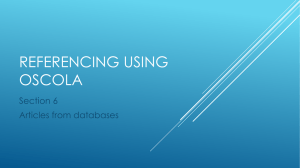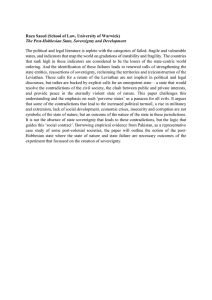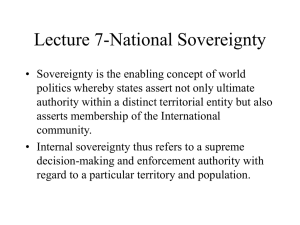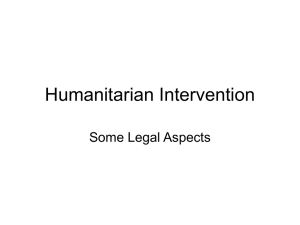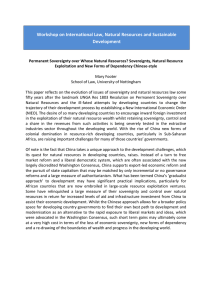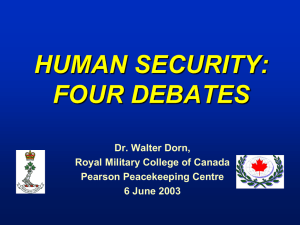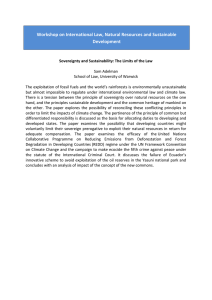Notes for Remarks by Paul Heinbecker Permanent Representative and Ambassador of
advertisement
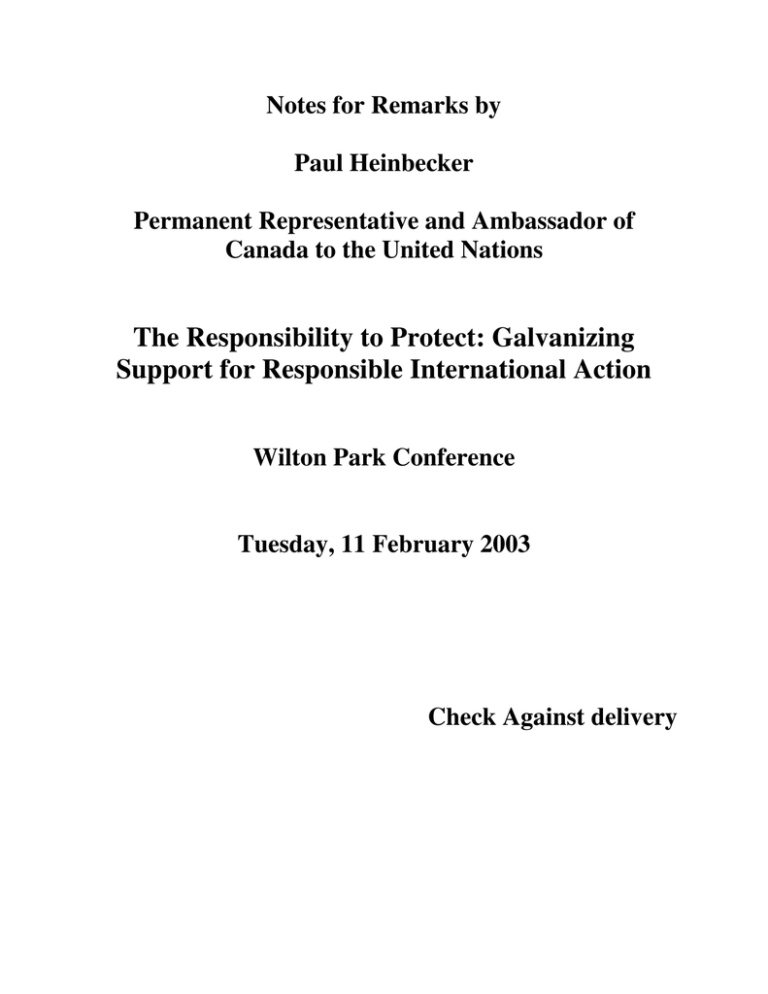
Notes for Remarks by Paul Heinbecker Permanent Representative and Ambassador of Canada to the United Nations The Responsibility to Protect: Galvanizing Support for Responsible International Action Wilton Park Conference Tuesday, 11 February 2003 Check Against delivery Military intervention is at the forefront of everyone=s mind today. Since September 11th, the kind of intervention that has dominated international debate has differed considerably from that of the previous decade. And indeed from that that motivated the Government of Canada to launch ICISS. Inaction on Srebrenica and Rwanda has given way to reaction against Afghanistan and, some argue, overreaction against Iraq. In the cases of Srebrenica and Rwanda, the issue was protecting Aother@. In Afghanistan and Iraq, the motivation is protecting Aself@. The latter is not by any means an illegitimate motivation but it is very different. Motives matter. These are, some would say, not good days to be considering the question of when military force should be authorized and deployed to protect others. It would be a mistake to believe that the question of how to respond to humanitarian crises is in any sense settled or is someone less important. The challenge posed by Secretary-General Annan in 1999 of reconciling state sovereignty with humanitarian values remains both relevant and urgent. And the challenge of mobilizing action to protect people facing atrocities is as difficult to meet as ever B especially people whose well-being does not engage the vital national interests or pose an immediate threat to anyone significant=s national security. Today I would like to discuss the prospects for responsible international human protection action and ways of achieving it. The Key Contribution of ICISS and the Responsibility to Protect The ICISS commission was the first comprehensive attempt to tackle the issue of sovereignty versus intervention and to reach consensus. It was modelled on the Brundtland Commission on the Environment and Development, which reconciled the apparently irreconcilable issues of economic development and environmental protection with the notion of Asustainable development@. We hoped that ICISS too would be able to reconcile seemingly irreconcilable notions -- of intervention and state sovereignty, through a similar process of political and intellectual debate. The 12 members of the commission and its co-chairs represented a wide spectrum of expertise and regional perspective. The built-in diversity of the Commission and the breadth and inclusiveness of its consultations make the consensus it reached, The Responsibility to Protect, all the more remarkable and compelling. All 12 members endorsed it; there was no minority opinion. It was a microcosm of what a global consensus could look like. The way the commission re-framed the debate is of fundamental importance. The issue was re-cast not as an argument about the Aright to intervene@ but about the Aresponsibility to protect@. In doing so, it shifted the focus onto the needs of people at risk, rather than the interests of the interveners. It is both a semantic and substantive shift. The commission also promoted the notion that sovereignty entails not only rights, but also responsibilities. The most fundamental responsibility of a state to protect its people. The R2P takes into account the impact in recent decades of human rights norms and the extent to which they condition the exercise of sovereignty. At the same time, it is also a return to much earlier notions of what sovereignty means, and of the role of the sovereign, namely to provide for the safety of its people. It should be stressed that the responsibility to protect remains a pro-sovereignty doctrine. The primary responsibility for protecting citizens rests with states. Strong, effective and accountable states are best able to protect their own people. But when states are unable or unwilling to provide this protection, or are themselves the perpetrators of atrocities, the Commission argues that the international community has a responsibility temporarily to become engaged, forcefully if necessary. Importantly, the commission defined responsibility to protect as having three dimensions: prevention, reaction and rebuilding. Reaction, including military intervention, is embedded in a continuum where it is defined as the last resort when all other preventive or diplomatic measures have failed, or there is a consensus that they would not have worked in time to save the vulnerable. While assigning very high priority to prevention efforts, the commission=s mandate was to examine the circumstances under which military force should be employed when civilian populations are at risk, the authority under which it should be conducted, and the modalities for its execution. The Commission reached agreement on a comprehensive framework for guiding forceful action to protect civilians, drawing on existing international law, just war doctrine, and the accumulated practice of collective action through the 1990s. I won=t enter into the detail of what the report says. Other speakers here have done so. And I assume that you=ve all read it anyway. Rather I=ll focus on how we hope to follow-up on its findings and recommendations. Follow-up Strategies: Operational and Normative In our view, there are two broad dimensions to effective followup on the Responsibility to Protect. The first is to ensure effective action in the face of the next humanitarian crisis. It is the practical application of the responsibility to protect in specific country situations through action by the Security Council, coalitions of member states, and regional organizations. The second is defining and consolidating the norms and standards that on the one hand govern the use of military force for the protection of civilians, and on the other, clarify the responsibilities inherent in sovereign status, particularly as they relate to the protection of civilian populations. Operational Each dimension of follow-up has its own challenges. First, the question of effective operational responses. As the report argues, this is a responsibility that lies first and foremost with the UN Security Council. The record of Council action in the 1990s demonstrates a willingness, albeit inconsistent and ineffective, to authorize enforcement action in support of the protection of civilians. The Council has also accepted this responsibility in principle in its resolutions 1265 and 1296 on the protection of civilians in armed conflict. The immediate challenge ahead is to ensure that the Council makes good on its responsibility to protect. These responsibilities range from preventive efforts through to post-conflict peacebuilding. But nowhere is the Council=s responsibility greater than in the authorization of enforcement action, including, in extreme cases, the authorization of the use of military force. The Council=s formal undertakings on the protection of civilians, from the two resolutions to the recent Aaide-memoire@ are important guides to action, as are the principles and criteria elaborated in The Responsibility to Protect. Recent Security Council mandates for peace operations in East Timor, Sierra Leone, Democratic Republic of Congo and most recently, Côte d=Ivoire, contain explicit provisions for the use of force to protect civilians, whether by UN-hatted forces or those operating under a UN mandate. Important precedents were also set by the two international criminal tribunals the Council established for the Former Yugoslavia and Rwanda. They clearly demonstrated that sovereignty provides no succour to individuals, including serving heads of state, who are responsible for war crimes and crimes against humanity. But principles and precedents, including those directly established by the Council, while helpful, are no guarantee for consistent or effective action in the future. The inconsistency of the Council=s contrasting responses in Kosovo, where it failed to act, and East Timor where it responded with despatch, may plague Council decision-making for the foreseeable future. Principles and precedents are more likely to be reflected episodically in more soundly configured peace operations and robust mandates for the protection of civilians. Given this reality, the best way of encouraging consistent and effective Council responses is through steady and concerted advocacy: by elected members of the Security Council; by the wider body of UN member-states; by the UN Secretariat and the humanitarian agencies; and by NGOs and civil society. Since Security Council responses have been inconsistent, far greater effort must be made to ensure that the Council puts into practice the principles that it has espoused. Canada=s time on the Security Council demonstrated the impact elected members can have by serving as champions of the protection agenda. Other elected Council members will need to continue to press for effective action in the face of emerging humanitarian crises. Civil society advocacy plays an increasingly important role in influencing Council decisions. Valuable work is already being done by NGOs, activists and others to raise awareness about forgotten humanitarian crises. But there is scope to do much more. Council responses to country-specific situations should be systematically monitored to ensure that the principles of the protection of civilians are actually put into practice. Recent innovations in Council working methods that have led to greater openness can be exploited and pursued further by the UN Secretariat and agencies, and by civil society advocates. The media also plays an important role by mobilizing public opinion and moving governments to action. Editorial decisions about which crises get reported and which do not can have a major impact on international responses. The concepts of responsibility outlined in The Responsibility to Protect report, whether on the part of nation-states or the international community, should have inherent appeal to the media which constantly seeks greater accountability from those with authority and power. Engagement of media on The Responsibility to Protect is therefore a key follow-up priority. Developing the Normative Framework In addition to promoting effective responses by the Security Council to specific crises, work is needed to embed the responsibility to protect within a wider normative framework. The Security Council is an important part of that framework, but the normative weight of its resolutions on the protection of civilians tends to be lightened by its case-by-case approach. There is still a high degree of scepticism among the broader community of nations regarding the need for robust action to protect civilians. For example, the Non-Aligned Movement resolution in the wake of the Kosovo intervention rejected outright the existence of a legal doctrine of humanitarian intervention. The gold-standard when weighing the norm of non-intervention with the imperatives of humanitarianism are set out in Resolution 46/182. While a sophisticated balancing of diverging interests the resolution focuses only on the provision of assistance B protection is not mentioned B and gives priority to traditional understandings of sovereignty. There are, however, some positive signs. The ICISS commission tapped into a growing acceptance that an absolute deference to sovereignty is unacceptable. Sovereign status carries with it responsibilities. Secretary-General Annan has hailed this finding as contributing to the removal of the Arhetorical cover@ once provided by sovereignty, and often used as a shield behind which abuse of people was committed with impunity. The notion of sovereignty as responsibility has also been strengthened by initiatives such as the Guiding Principles on Internal Displacement. While not a resolution, treaty or formal agreement between states, the Guiding Principles have been gaining wide acceptance by UN member states, and observance of them is growing. Championed by Francis Deng, the Representative of the Secretary-General on Internal Displacement, the Guiding Principles serve as an important tool for holding sovereign states to their responsibilities to protect internally displaced persons, and when they are unable or unwilling to do so, to allow the international community to step in. There have also been progressive developments at the regional level, particularly in Africa. Ironically, the impetus for these development has, at least in part, been inaction or indifference by the Security Council itself. Interventions by ECOMOG in Liberia and Sierra Leone, while subsequently authorized by the Security Council, were authorized in the first instance by ECOWAS itself. Here theory is following practice. ECOWAS, but also the African Union and SADC, have recently included in their organizational charters explicit provisions for intervention to curb genocide, war crimes and crimes against humanity. Some go even further in justifying intervention to reverse undemocratic overthrow of government. These have served to place clear conditions on what sovereign status means, and to introduce the concept of sovereignty as entailing responsibilities, not unadulterated rights. These standards, however, are not yet shared by other regions. In Asia, where concepts of non-confrontation and noninterference reign, such porous notions of sovereignty and collective responsibilities have not taken hold. What then are the options for developing and consolidating norms around the responsibilities inherent in sovereignty and the subsidiary responsibilities of the community of nations? How can they best be expressed? Some might argue that continually pushing for effective responses to specific situations is a wiser strategy because more states may be willing to support robust action, even if it amounts to a breach of sovereignty, if it is presented as an exception rather than a norm. Should we instead focus on developing Aoperational norms@ rather than the overarching normative framework? Do we risk reversing progress by seeking to turn accumulated practice into explicit norms? The most important forum for the expression of universal norms is of course the UN General Assembly. That is why Canada has launched a process of dialogue on the responsibility to protect in that body. We have circulated the report as a UN document and introduced it as an item on the formal agenda of the GA. Even these modest beginnings have encountered stiff resistance, suggesting the even greater challenges that face efforts at achieving any substantive outcome. We take it as given that there will not be a legally binding convention or an amendment to the UN Charter. Charter amendment is not only highly unlikely, it is probably unnecessary. There have been many extra-Charter innovations which have helped give expression to evolving international norms, including General Assembly resolutions and declarations. Canada will continue to explore the possibilities for a General Assembly process that could lead to a resolution or a declaration on the responsibility to protect. We will be holding roundtables and other informal dialogues to explore the full dimensions of the protection issue. We have also made it clear that this continued debate is not an end in itself, and that it must lead somewhere. It will not be rushed, but neither will it drag on indefinitely. We believe that any negotiation launched in the General Assembly should be reinforced by the engagement of a wide range of interested constituencies outside of that forum. That is why we will continue working with human rights and humanitarian NGOs, parliamentarians, think-tanks and the media. Any General Assembly working group or committee should hear from these voices, and wider civil society should have direct input to the inter-governmental process. It will also be important for the regions and sub-regions to have their say. Through a strategy of concerted regional engagement on the responsibility to protect, involving a broad cross-section of key constituencies, we can hope to influence positively the positions taken at the UN by member states and their powerful regional groupings We also hope to continue with the model of public-private partnership used by ICISS, which included active support from important foundations such as MacArthur, Hewlett and others. Such new diplomacy partnerships have been key to the success of important international campaigns, from the landmines ban to the International Criminal Court to the responsibility to protect. Other avenues for strengthening norms of protection will also be explored in parallel, for example the kind of process that produced the Guiding Principles on Internal Displacement. The norm-building effort can also be taken to other UN bodies and mechanisms, for example the Inter-Agency Standing Committee which brings together the heads of the major UN humanitarian agencies. The UN Secretary-General is also a crucial ally. On his own initiative he is using the language of the responsibility to protect in key statements and reports. We will look to him to continue to lend his personal leadership and conviction to the protection agenda. Conclusion Clearly the responsibility to protect involves further challenges at the political, normative and operational level. But the ICISS report provides a helpful framework and roadmap to guide the decisions that will inevitably need to be made when conscience-shocking situations cry out for action in the future. I believe it is fair to say that the gulf in the protection debate has narrowed in recent years. Who today would question that there should have been action to stop the genocide in Rwanda? The Responsibility to Protect should appeal to those with legitimate concerns about intervention. The report is about more, not fewer, rules to govern the use of force by the international community. It is also about enabling the UN and the Security Council to do its job better and more consistently. It is a hedge against unilateralism or action taken without Security Council authorization. Canada’s goal is to build as broad and strong a consensus as possible, the consensus that Secretary-General Annan challenged us to achieve. Canada’s goal is also to keep the UN and its unique legitimacy at the centre of that consensus.

